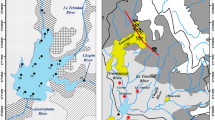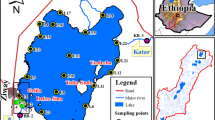Abstract
Many lakes in eastern Canada are sensitive to long range transport of atmospheric pollutants because of their low buffering capacity. Thus, it is important to assess long term changes in water quality. Due to the large number of lakes, a method was needed for choosing a subset of lakes to monitor regularly. Preliminary surveys were conducted in Nova Scotia and Newfoundland in which water quality parameters connected with acidification were measured in a set of lakes in each region. This paper describes the division of each set of lakes into several groups, with lakes in a group having similar water quality parameter values, by means of cluster analysis and principal component ordination. The characteristics of the groups are shown by graphical procedures and summary statistics, and this characterization is used to both determine the number of groups and describe the final choice. The membership of the groups was subsequently assessed in terms of the influences of terrestrial weathering, marine aerosols, anthropogenically derived mineral acids and natural organic acids.
Similar content being viewed by others
References
Anderberg, M.R.: 1973, Cluster Analysis for Applications. Academic Press, New York, 359 pp.
Environment Canada: 1979, Analytical Methods Manual. Inland Waters Directorate, Water Quality Branch, Ottawa, Ontario.
Esterby, S.R., El-Shaarawi, A.H., Howell, G.D., and Clair, T.A.: 1989, ‘Grouping of Lakes on the Basis of Water Quality Variables. An Application to Nova Scotia and Newfoundland Lakes‘. NWRI Contribution No. 89-24.
Hartigan, J.A.: 1975, Clustering Algorithms. Wiley, New York, 351 pp.
Howell, G.D.: 1986, ‘Water Quality Characterization of 78 Acid Precipitation Monitoring Lakes in Atlantic Canada’. Inland Waters Directorate. Water Quality Branch Report IWD-AR-WQB-86-109. July, 1986. 119 pp.
Howell, G.D. and Pollock, T.L.: 1986, ‘Sulfate, Water Color and Dissolved Organic Carbon Relationships in Organic Waters of Atlantic Canada’. In: A.H. El-Shaarawi and R.E. Kwiatkowski (eds.). Statistical Aspects of Water Quality Monitoring. Developments in Water Science. 27: 53–63.
Howell, G.D. and Brooksbank, P.: 1987, ‘An assessment of LRTAP acidification of surface waters in Atlantic Canada’. Inland Waters Directorate. Water Quality Branch Report IW/L-AR-WQB-87-121. 292 pp.
Kerekes, J., Howell, G. and Pollock, T.L.: 1984, Verh. Internat. Verein. Limnol. 22: 1811.
Morrison, D.F.: 1967, Multivariate Statistical Methods. McGraw-Hill, New York, 338 pp.
Ogden, J.G.: 1982, Water, Air and Soil Pollut. 17: 119.
Shaw, R.W.: 1979, Environ. Sci. Technol. 13: 406.
Shaw, R.W.: 1982, Atmospheric Environment. 16: 337.
Author information
Authors and Affiliations
Rights and permissions
About this article
Cite this article
Esterby, S.R., El-Shaarawi, A.H., Howell, G.D. et al. Spatial characterization of acidification related parameters in sensitive regions of Atlantic Canada. Water Air Soil Pollut 46, 289–303 (1989). https://doi.org/10.1007/BF00192864
Received:
Revised:
Issue Date:
DOI: https://doi.org/10.1007/BF00192864




